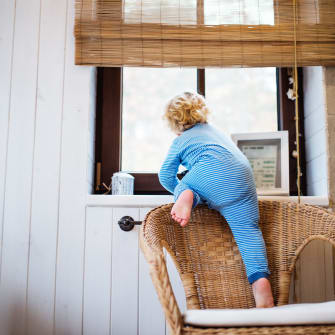
Putting the prevention in preventable injuries
This year Mary Bridge Children’s Hospital is celebrating the 40th anniversary of its renowned Center for Childhood Safety. We continue to prioritize child safety because unintentional injury continues to be the leading cause of death for children. These injuries tend to follow predictable patterns, and most are preventable with a combination of knowledge, safety devices and careful habits.
Fatal injuries are preventable — so let’s do that.
Bumps and bruises are part of childhood, but when it comes to potentially fatal injuries, we should do everything we can to reduce the risk of danger. “Childproofing” requires attentive caregivers to prepare for how quickly those risks will change over time. It can feel like one minute we’re worrying about baby choking on a toy, and the next we are nervously handing our teen the car keys.
With young children it helps to get down to their level and see what they can see (and reach). As kids grow, it is important to normalize safe behaviors and model safe choices yourself. For example, when parents wear seat belts and helmets, kids are more likely to do the same.
Safety tips to prevent common child injuries:
- Place infants in a safe crib, bassinet or pack-n-play for sleep, naps and nighttime
- Use car seats and seat belts correctly — have your car seat checked by a CPST
- Block access to electrical outlets and cords
- Keep household poisons (medicines, cleaning supplies) up and out of reach
- Keep firearms unloaded and in a lock box or gun safe
- Cut or tie up window cords, to eliminate strangulation risk
- Add window stops to accessible windows, allowing them to open only 4”
- Anchor furniture and TVs to the wall
- Follow age guidelines on toy packaging—keep big kid toys away from little kids
- Avoid baby bath seats and never leave young children alone while bathing, even for a moment
- Closely supervise all children around water or while swimming
- Teach children how to swim, and keep their skills up with lessons each year
- Use USCG-rated life jackets when on/near open water (not arm floaties) — check for proper fit
- Test smoke alarms regularly and keep bedroom doors closed at night
- Do not place hot drinks or food where a young child can reach
- For young eaters, cut food into small pieces to prevent choking — especially round items like grapes and hot dogs
- Wear a well-fitted helmet on wheeled toys and for snow sports — rated for the activity
- Follow graduated driver licensing laws for young drivers
What are the latest trends in childhood injury?
One thing I’ve learned in my many years of injury prevention work is that kids are very creative at finding ways to hurt themselves. From laundry pods that look like candy to questionable TikTok trends, smart caregivers keep their eyes and ears open for new challenges coming their kids’ way.
Looking at national data and injuries we are seeing here at Mary Bridge Children’s, here are a few newer risks to look out for:
- Electric scooters – Not recommended for kids under 16. They move very fast, are hard to maneuver safely, and helmet use is uncommon (always wear a helmet!).
- High-powered magnets – A popular desk toy, these powerful tiny magnets are extremely dangerous when a child swallows more than one, as they pull toward each other causing tissue damage, infection and internal bleeding.
- Button batteries – Small flat batteries can cause severe burns when swallowed. These are typically found in small electronic devices, light-up decorations and even musical greeting cards.
- Water beads – Small gel-filled balls used as sensory toys or decoration, they come in bright colors and look like candy. They expand when wet, causing blockages that are not always visible on an x-ray.
Questions about childhood injury prevention? Visit our website or reach out to our team at [email protected].